For the first time in decades, the Nike Air Ship set sail at retail in 2020.
Simple in styling but rich in folklore, the underloved ‘80s style has grown in fanfare over the course of the last decade thanks to a resurgence in vintage and collectible sneakers , an appetite for niche storytelling and the recent ramp in success of its successor, the Air Jordan 1.
From a sneaker culture standpoint, the Air Ship matters a lot in the appropriately odd 2020. But what did it look like in the early ‘80s?
Before the Ship, Nike Basketball was born from the Bruin in 1972. A low top look, the Bruin served as a banner for Nike’s bold Swoosh branding with uppers alternating from suede to leather atop an autoclave sole. Growing locally, Portland Trailblazers fan favorite Llloyd Neal would lace up the Bruin in the newly formed Nike’s backyard. Technically and aesthetically, the construction and styling of the Bruin was essentially on par at that time with adidas alternatives, Converse contemporaries and Pony peers.
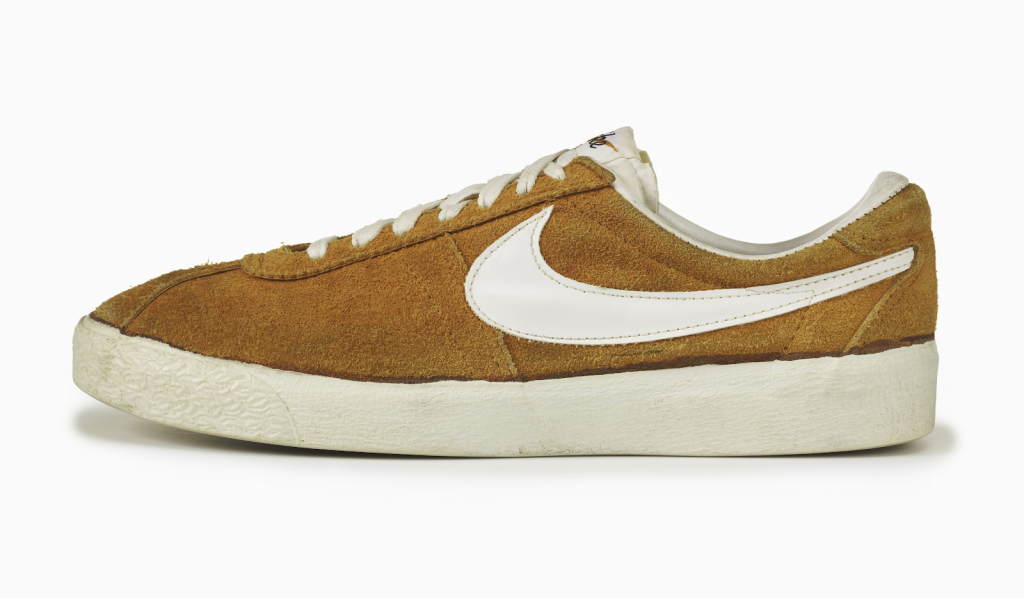
Nike Bruin via Nike, Inc
Over the course of the next decade, the Blazer would take the torch for Nike as a slightly sharper and certainly taller take on the Bruin. Though the Blazer would age well over time and see All-Star endorsements, from a technical standpoint it would share similarities in construction and tooling to the adidas Pro Model or Converse Pro Leather out in the same era.
It wouldn’t be until 1982 that Nike found its identity in innovation with the Air Force 1, designed by the great Bruce Kilgore.
Repackaging the atmosphere’s most abundant resource into a modern form of cushioning, Nike Air technology soon became the calling card for the brand as a whole, especially in the basketball category. The Air Force 1 would bring Nike Air technology to the hardwood and introduce a technical mystique to the world of footwear that would sell shoes for decades to come.
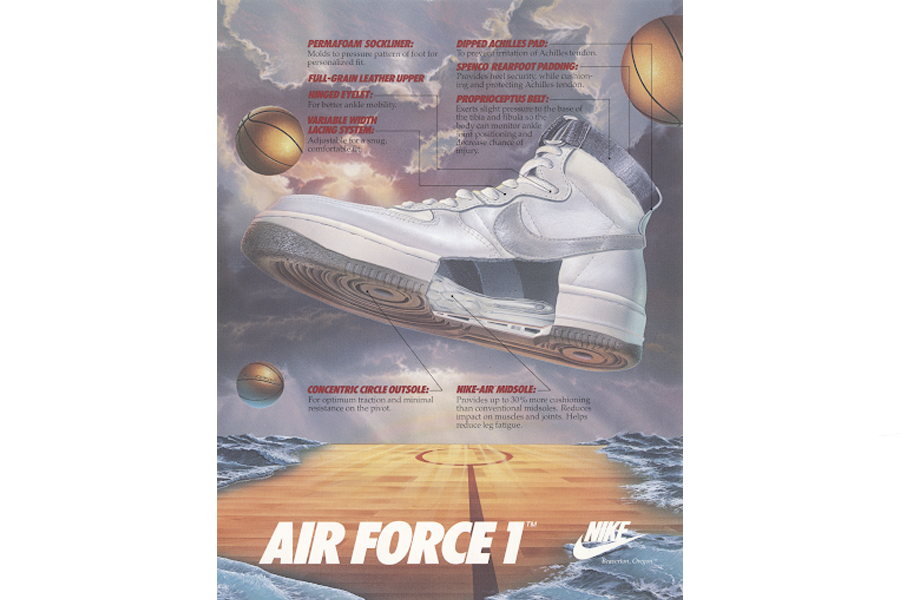
Nike Air Force 1 High via Nike, Inc
In 1982 and 1983, the Air Force 1 would be the only basketball shoe Nike released that was bolstered by Air. In 1984, they’d widened that range with the release of the Air Train and the Air Ship — then branded as Airtrain Hi and Airship Hi.
Almost identical in appearance, both the Train and the Ship deviated slightly from the Air Force 1 by retaining similar tooling but scrapping the strap. Beneath the surface, the Air Force 1 would sport encapsulated Air in full-length fashion while the Ship and Train would only feature Air in the heel.
Up top, the Train featured a mix of mesh and leather on the upper, while the Ship was strictly leather with reinforcements added on the forefoot. While both were privy to team pricing for high school and college clubs, the Ship retailed at $75 while the Train came in at a cool $50 – half the price of the high top Air Force 1.
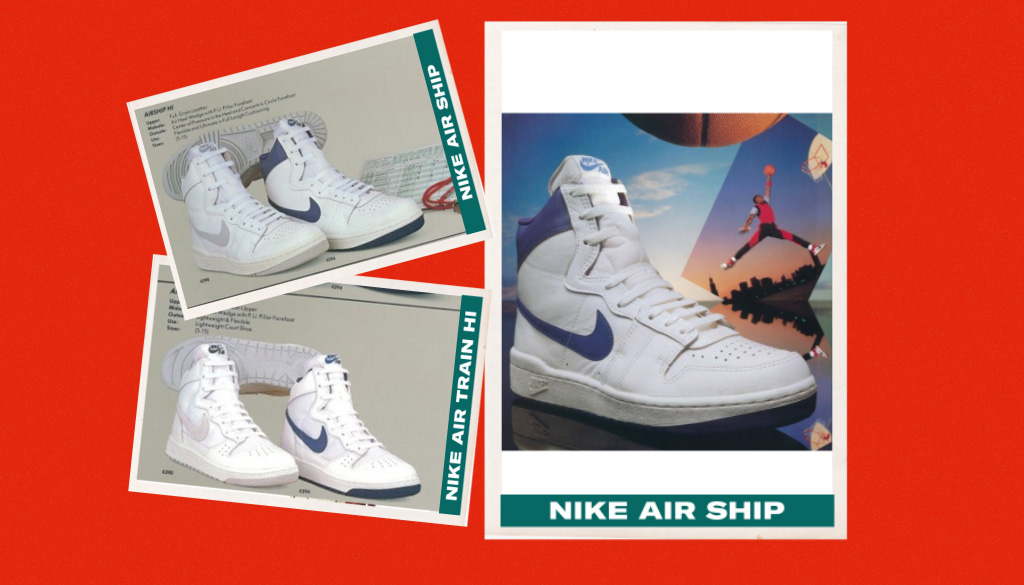
Nike Air Ship & Air Train 1985 Catalog Shots via SneakerQueen
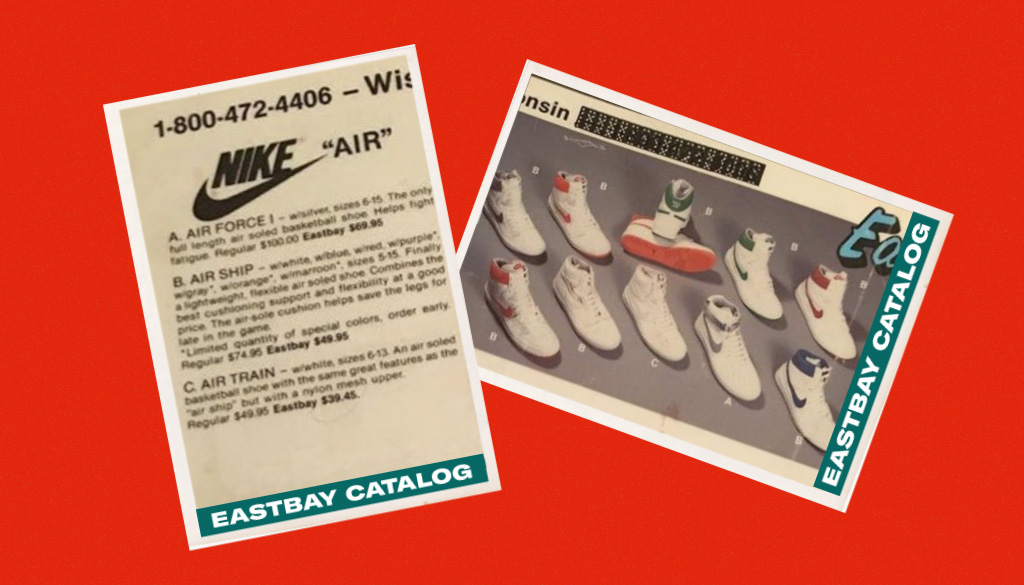
1984 Eastbay Catalog via Sneaker Dave
In 1984, it was clear that Air was set to lift the likes of Nike’s top teams in the college game and also outfit the NBA’s elite. By ‘84, George Gervin would backseat the Blazer in favor of the Air Force 1 High down in San Antonio with Moses Malone rotating the Air Train Hi with that of the Air Force 1 Low in Philly.
Yes, Nike Basketball’s top vets were wearing the brand’s banner technology heading into the 1984-85 NBA season. What the world didn’t know is that same season a rookie on the Swoosh roster wouldn’t just wear Air, he’d become it.
Steered by basketball branding savant Sonny Vacarro and super agent David Falk, Michael Jordan would defy Converse convention and adidas admiration to become something entirely different at Nike. Set to be basketball’s first signature athlete sold in the same singular fashion as a tennis player, Nike and Jordan intended to bring individuality to basketball footwear and it all began with the Air Ship.
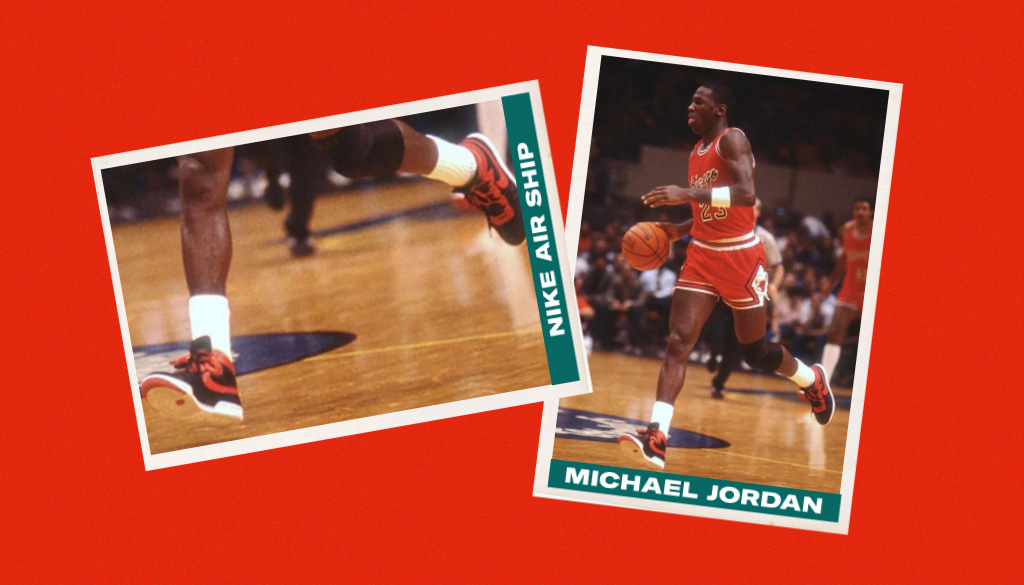
Photo via Aaron Goodwin
For Mike to be marketed differently, he had to look different. Slam dunks aside, this aesthetic elevation literally and figuratively began with his feet. While an Air Jordan signature shoe was in the works, led by Nike creative director Peter Moore, it wouldn’t be ready by the start of the season so a Player Exclusive makeup would have to suffice.
Before MJ, Player Exclusives were then very much what they are today: a badge of honor for a star or team that deserved specialized denotion in the form of specialized sneakers. Around the NBA, league favorites like Maurice Cheeks, George Gervin and Kevin McHale would see their famous last names stamp the heels of Blazers, Bruins and Terminators with color blocking matching that of their uniforms.
Heading into the ‘84-’85 preseason, Mike’s first pair of PEs would see more than just team tones and last name tagging.
Upping the ante on the age old formula, Mike’s exclusive Air Ships introduced a wildly bold Black/Red-White color palette. This was by design. Prior to Chicago drafting Jordan, the Bulls played in White/Red sneakers over the course of the 83-84 season and were assumed to have every intention of doing so for that of 84-85. By making Mike the only member of the Bulls donning black shoes, he stood out amongst his peers on TV, in the papers and in the arena.
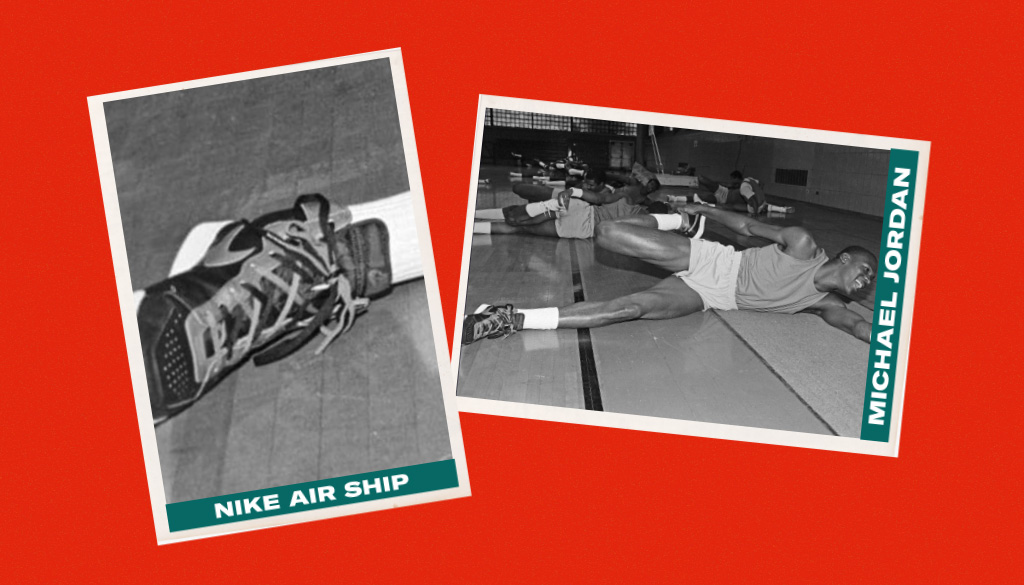
Photo via Getty Images
Before this blocking could catch the eyes of fans set to find out they had a new hero, it caught the eyes of David Stern and the NBA league offices. Jordan was to be fined if he violated the league’s strict uniform rules, thus leading the Black/Red color combo to be known as the “Banned” motif.
The colorway made history, creating the marketing movement behind the Air Jordan 1s of the same blocking once ready for retail. Bold shades aside, there was much more going on with Mike’s first Ship PE than just black and red leather.
Cut down from a high to what would now be considered a mid, Mike’s Ship PE was noticeably shorter in height than that of the Ships worn around the league. Closer to the court, the “Banned” Ship PE also lifted the sole from Nike’s Pro Circuit Tennis shoe – an odd modification that spoke to the signature success and category crossover Falk and Vacarro had in mind.
Also of note, MJ’s Air Ship PEs did not just have ‘Jordan’ stamped on the heels, but rather ‘Air Jordan.’ Before making a name for himself in the NBA, Nike and Jordan’s marketing team had already done so. Tying Mike’s ability to fly with that of Nike’s new tech, Air Jordan was born before Mike’s game had even taken off. This was a step beyond putting ‘Iceman’ on George Gervin’s Blazers after he’d established himself as an All-Star. Essentially, this was like the Hawks putting ‘Pistol’ on the back of Pete Maravich’s jersey for the home opener and soon selling toy guys at the team store.
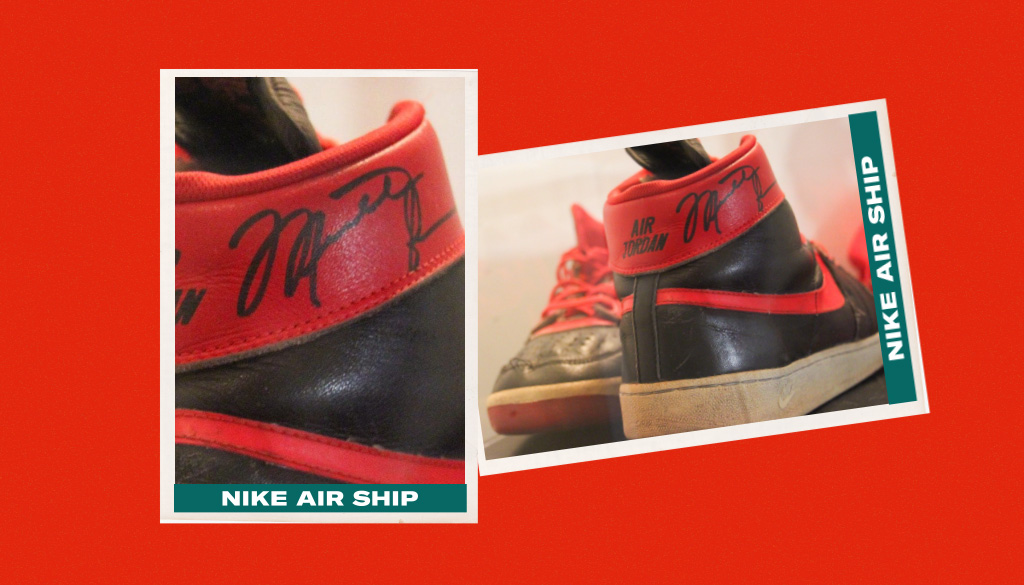
Photo via Aaron Goodwin
Through his Ship PEs, Air Jordan was born and ready for takeoff. Due to league mandates, Mike’s “Banned” Ships would only see the court over the course of the Bulls’ seven game preseason schedule. Rumors range on just how many pairs of the Pro Circuit soled Black/Red PE were produced with all estimates suggesting less than five pairs in total.
Because of the fines, Mike and Nike had to adjust. Heading into MJ’s official opener, Nike had no leeway from the league on color blocking but once again angled to the idea that both Mike and his shoes were made to be different.
Donning a White/Red Air Ship PE in his regular season rookie debut and for much of the fall of 1984, the second sneaker sported by Mike in NBA play once again featured a mid cut alteration and a sole swap. While the Pro Circuit capping was shelved on the second style, the Air Jordan 1 sole would appear on the White/Red rendition as a transition to his coming signature. This same segue would be brought back Nike years later when Kobe rocked a Hyperdunk upper with the sole of his upcoming Kobe IV.
Was it the shoes? In the fall of ‘84, Mike’s White/Red Ship PEs were good enough to carry him to a 45 point performance and win against George Gervin’s Spurs. The stat sheet and the shoes both foreshadowed what was soon to come.
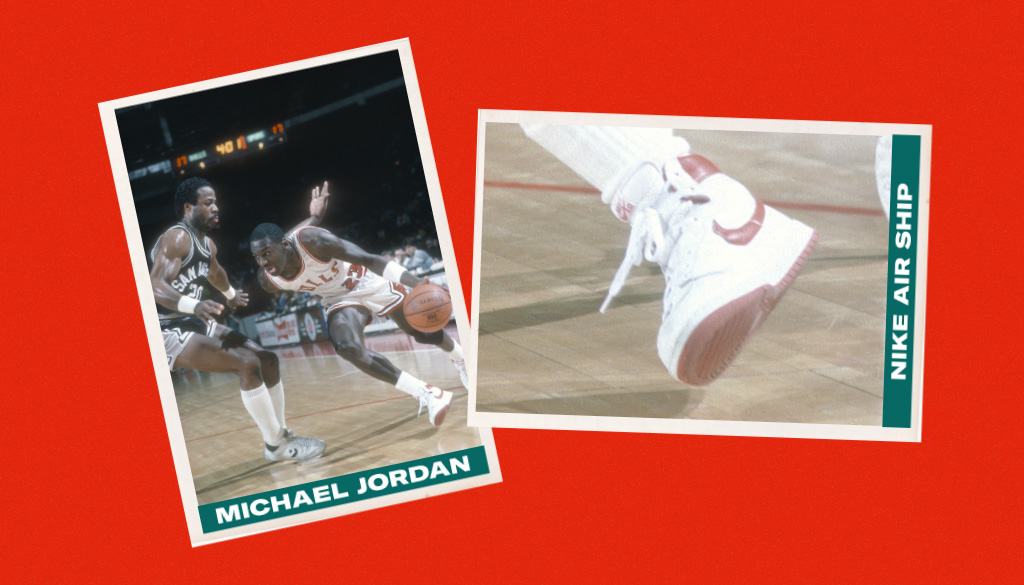
Photo by Focus on Sport/Getty Images
What was soon to come was the Air Jordan 1 – technically speaking a takedown of the Air Ship but an informed exercise of the shoe’s lessons learned when worn by the man who changed everything.
While Peter Moore gets design credit for the Air Jordan 1, it was Bruce Kilgore who helmed the Air Ship. When considering the hybrid nature of Mike’s Ship PEs in regard to blocking and tooling, one could consider MJ’s exclusives a joint effort between Kilgore and Moore in effect.
Over the course of the 84-85 season, MJ would transition from his Ship PEs to that of the Air Jordan 1 with the Air Train also getting wear in game from Mike.
Worn once against the Clippers in LA, it’s likely Mike picked up the Air Train on a West Coast road trip when checking in with his team in Beaverton.
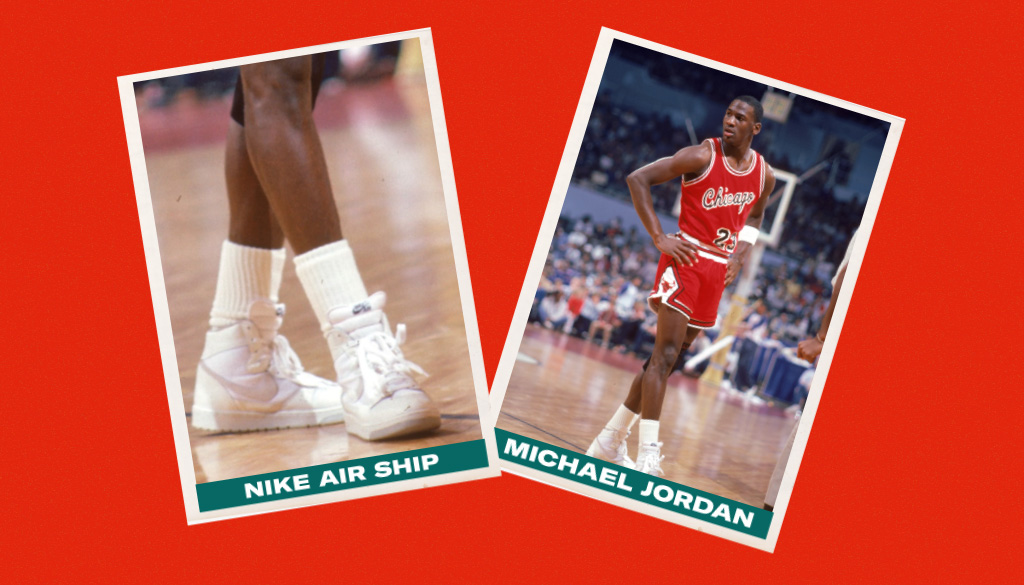
Michael Jordan in the Nike Air Train (Photo by Rick Stewart/Getty Images)
While the Ship would sail away from the limelight presented by MJ in PE form, the shoe, its endorsements and its alterations would forecast the Flight line before it existed.
Around the league, reigning Slam Dunk Champion Larry Nance would switch to the Ship in 1985 after proving his slamming supremacy in Converse back in 1984. While big men on the block like Moses Malone and even a young Barkley were making the Force line their own, leapers in the paint and athletic wings at all levels were gravitating to the Ship in its inline form.
In the 1985 Dunk Contest where Mike famously debuted the “Banned” Air Jordan 1s, Darrell Griffith and Larry Nance would both lace the Nike Air Ship in White/Purple form.
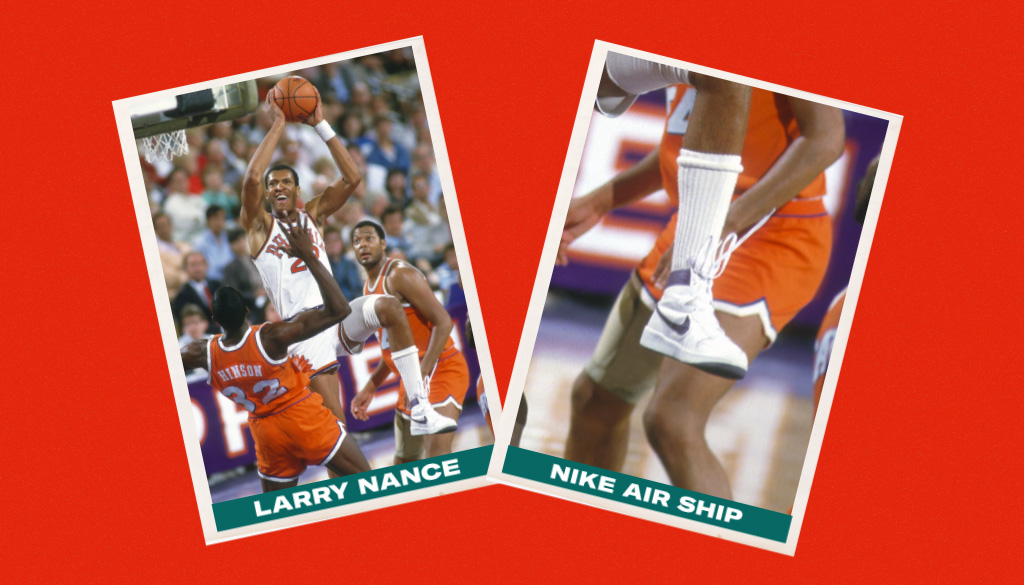
Larry Nance in the Nike Air Ship White/Purple (Photo via Valley of the Suns)
Across the college game, touted talent like Maryland’s Len Bias would wear the Ship in White/Red while providing athletic play on the wing.
Built for a more agile player than the Force camp favorites who banged on the block, the inline Ship was touted for its ‘lightweight and shock absorbency usually found only in the best running shoes.’ Still solid enough for post-poster landings, the heel Air Wedge for shock absorption was contrasted with forefoot cushioning pillars for flexibility and thus court feel.
With a tech booklet that positioned it as futuristic, the Ship had more bells and whistles than a referee collecting coins for Unicef. Compared to its predecessors like the Blazer or the Bruin, the Ship was decidedly different and engineered through innovation.
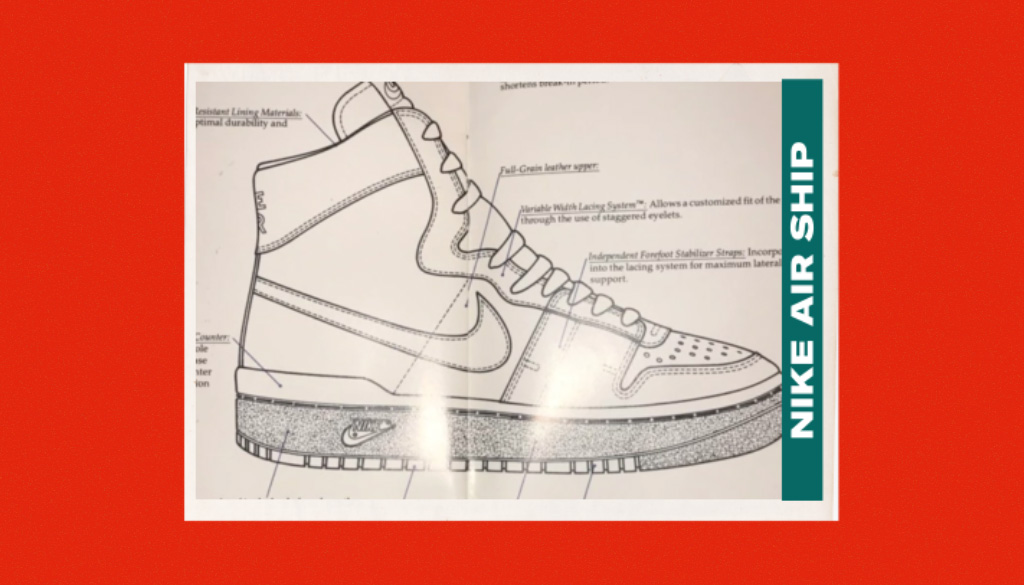
OG Nike Air Ship tech booklet via Grailed
Simply put, the Ship was shaped for a new generation of players that could fly from baseline to baseline and still rise above the rim. Performance standards were now being set to the exact specifications of a championship athlete as the Beaverton brand would later tout.
In Michael Jordan, Nike had the ultimate muse to retool the formula for Flight quite literally on the fly with the Ship. By doing so, Mike and Nike would introduce an athlete and a series of sneakers set to be much more marketable, personable and exciting than the big men and big shoes that once dominated the NBA. The Air Jordan franchise would elevate the player best known to levitate while the Flight series would also cater to above the rim forwards and explosive guards.
Through Mike and Nike’s reworking of the Ship individualism was born in regard to shades and styling. The tri-tone color blocking banned by the NBA in black and accepted in white via “Chicago” and “Black Toe” 1s would soon be the standard for other brands to follow as Converse Weapons, adidas Attitudes and Pony City Wings would all carry three colors associated with their individual endorser’s team uniforms rather than the standard two.
Even if prophecy wouldn’t be realized until the Air Jordan 1, it all started with the Ship.
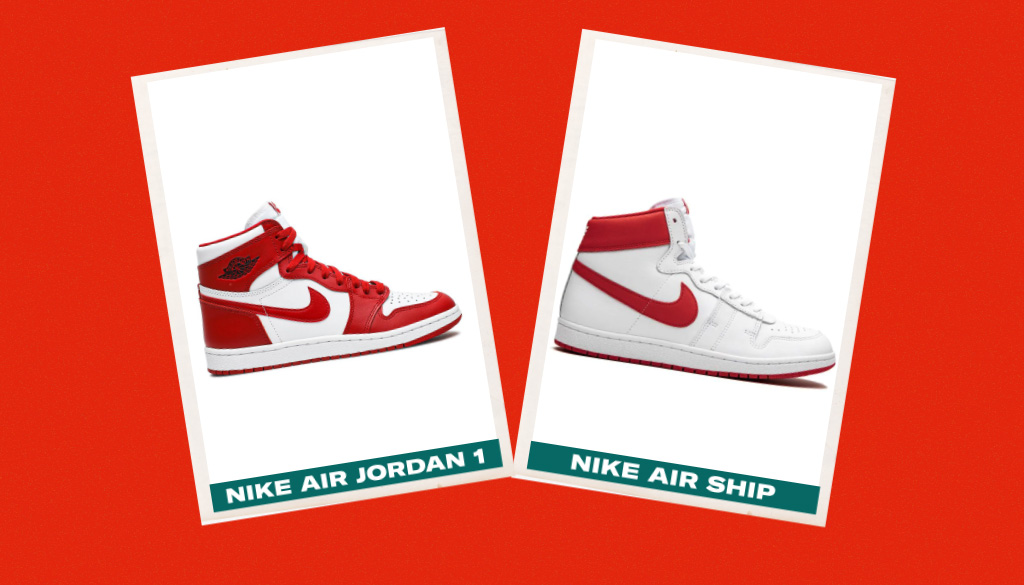
Air Jordan “New Beginnings” Pack
After three and a half decades of being ignored aside from online petitions and a cryptic @Jumpman23 Tweet, the Nike Air Ship PE returned in retro form for the first time ever in 2020.
Debuting at All-Star Weekend in Chicago, the White/Red regional release was exclusive to the festivities and launched aside an Air Jordan 1 of the same sentiment in the “New Beginnings” package. As Brendan Dunne of Complex notes, the introductory Air Ship retro release sports an Air Jordan 1 sole just like Mike’s mid cut, White/Red game pair from 1984.
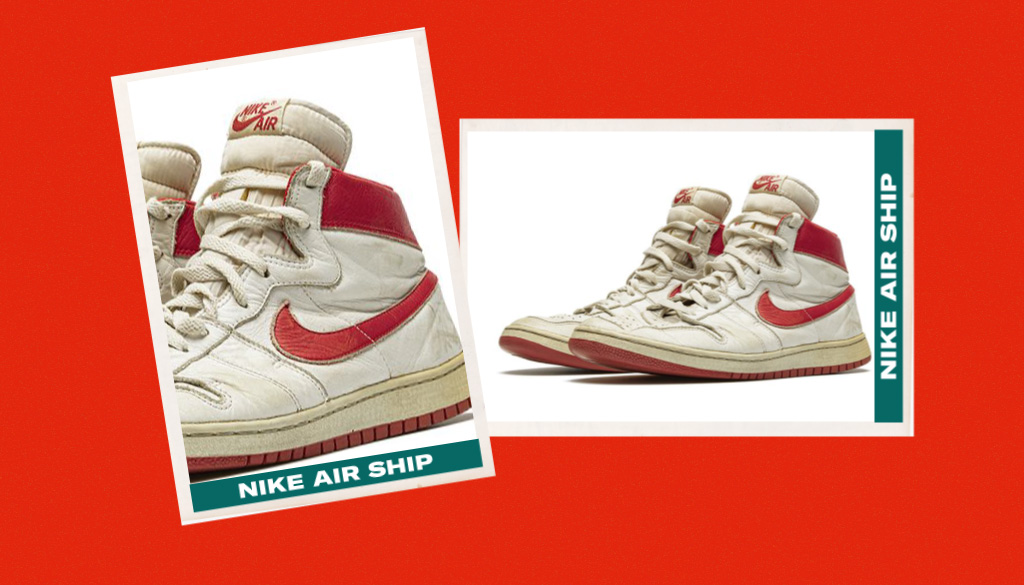
OG Nike Air Ship White/Red Michael Jordan PE via Christie’s
Playing well to retro revival and The Last Dance buzz, months after All-Star Weekend a pair of OG Nike Air Ship White/Red PEs made for Mike and worn in a game went live for auction on Christie’s in partnership with Stadium Goods. The estimated value for Mike’s Ship PE was listed between a whopping $350,000 to $550,000.
But it didn’t end there.
Without warning, the famed “Banned” Air Ship PE also received its long-awaited retro release in August 2020. Launching exclusively at Back-Door Bottega in Italy, the retro release brought back the Black/Red-White blocking banned by the NBA and introduced by Mike and Nike.
Much like the White/Red release from All-Star Weekend, original details specific to Mike’s personal PEs were very much intact. Most notably, ‘Air Jordan’ heel stamping appeared as did the tennis sole lifted from the Nike Pro Circuit. While the OG inline Air Ship sold the idea of heel Air and forefoot flex, the “Banned” Ship retro release – rebranded as the Air Ship Pro – inserted React cushioning for a modern feel.
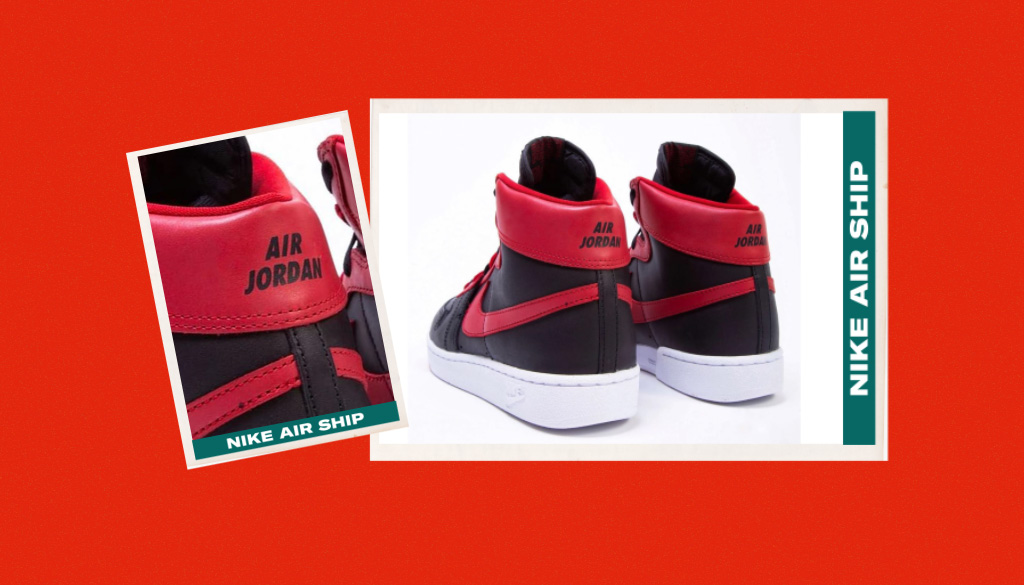
Nike Air Ship Pro “Banned”
Even after dual drops with OG, player exclusive detailing specific to MJ, Nike’s near future or long term plans for the Ship remain uncertain. Will the Ship receive the retro treatment in inline form with team tones tied to Larry Nance and Len Bias or will it sail back to the archives as it did for 30 odd years?
At the moment, it’s clear that Nike is nodding to Mike’s starting point and acknowledging historians with both Ship retros even if brand barriers keep them from explicitly telling the story. After years of collectors being left in the dark, Mike’s modified mid tops are finally back even if released in extremely limited form.
Three decades later, the Ship is seeing its due and another chapter in the elusive tale has been written. The only question is, will the story end here?

